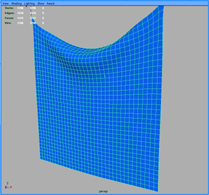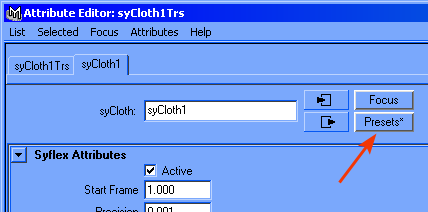

|
Live Mode | ||||||||||||||||||||||||||||||||||||||||||||||||||
|
Live mode allows to run the simulation at the current frame without running
the animation. You can use this to let the cloth reach a stable position at the first frame of the animation. To put a cloth in live mode:
Always stop the simulation before : - Running the animation, - Saving the Maya file, - Working on another cloth. | ||||||||||||||||||||||||||||||||||||||||||||||||||
|
Dimension | ||||||||||||||||||||||||||||||||||||||||||||||||||
Syflex implements a simulator based on physical equations. Each
parameter of the simulation has a physical meaning, and is expressed
with specific units. These units are combinations of 3 base units:
For instance, on earth the magnitude G of the gravity is G = 9.81 m/s². If your units are centimeters (1 meter = 100 centimeters), and frames (1 second = 30 frames) then the value for G must be: G= 9.81 m/s² = 9.81*(100 cm)/(30 f) ² = 1.09 cm/f². Go to the next paragraph for example of values, depending on the units you are using. Dimensions can also be used in various situations:
| ||||||||||||||||||||||||||||||||||||||||||||||||||
|
Example of Values | ||||||||||||||||||||||||||||||||||||||||||||||||||
In order to set appropriate values for the simulation, you need to know what
the units used in your scene are.
For instance, in the case of this simple scene consisting of a rectangular
1 by 1 meter piece of cloth: If the cloth measures, in Maya units, 1x1, then you are using meters. If the cloth measures 100x100, then you are using centimeters. And if it is about 3x3 then you are probably using feet. Here are a few examples of values, depending on different units. In these tables, units are in: m(meter), g(gram), Kg(Kilogram), s(seconds) etc.
If you have JavaScript enabled, you can use the following table to compute defaults values for your units:
Other parameters don't have dimensions, and don't depend on your units. This is the case for the following attributes:
| ||||||||||||||||||||||||||||||||||||||||||||||||||
|
Presets | ||||||||||||||||||||||||||||||||||||||||||||||||||
|
For each node, you can set default parameters. You first need to check what units you are using (centimeters or meters, etc). Then for each node you can find presets values, using the Attribute page:  | ||||||||||||||||||||||||||||||||||||||||||||||||||